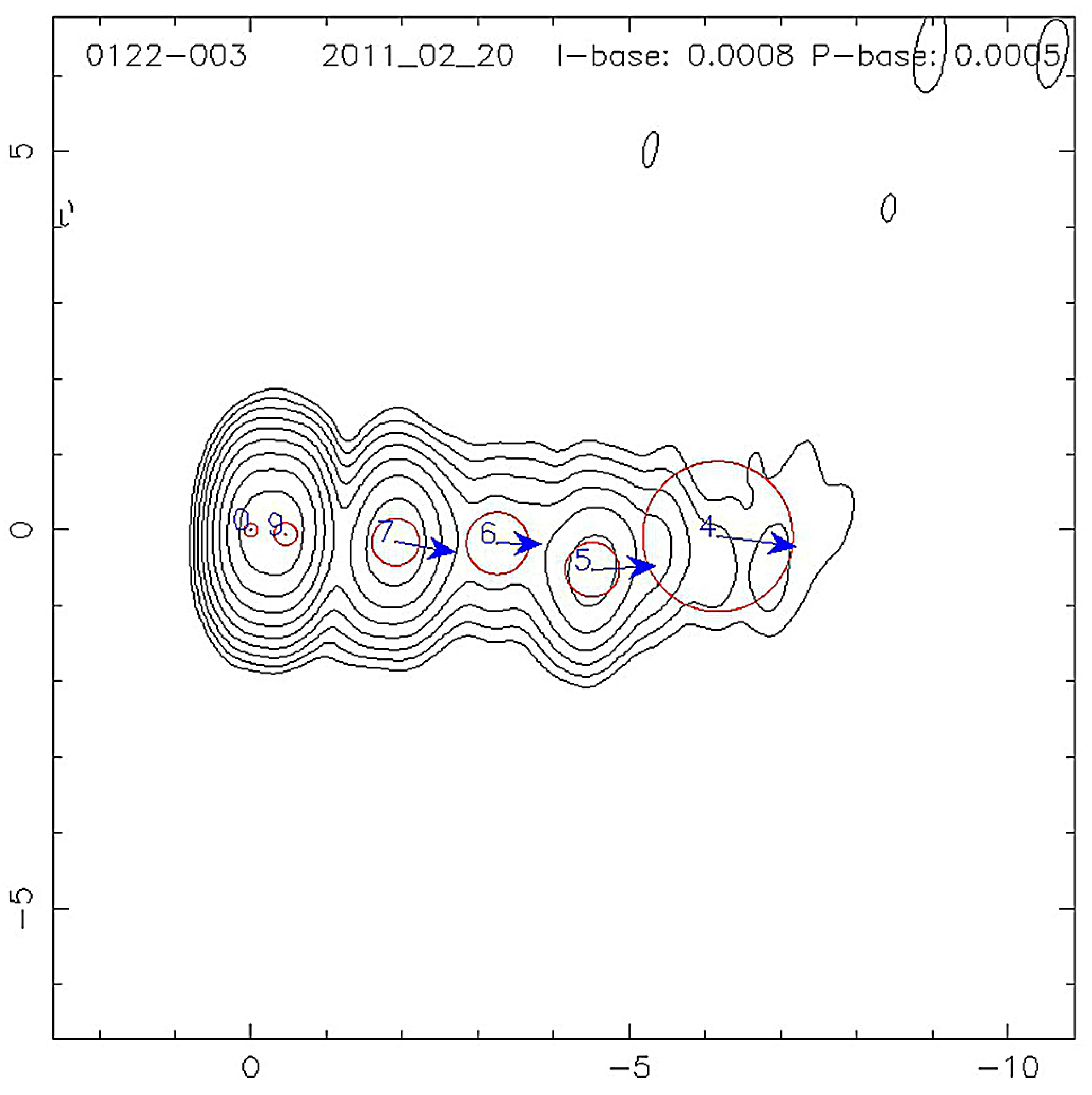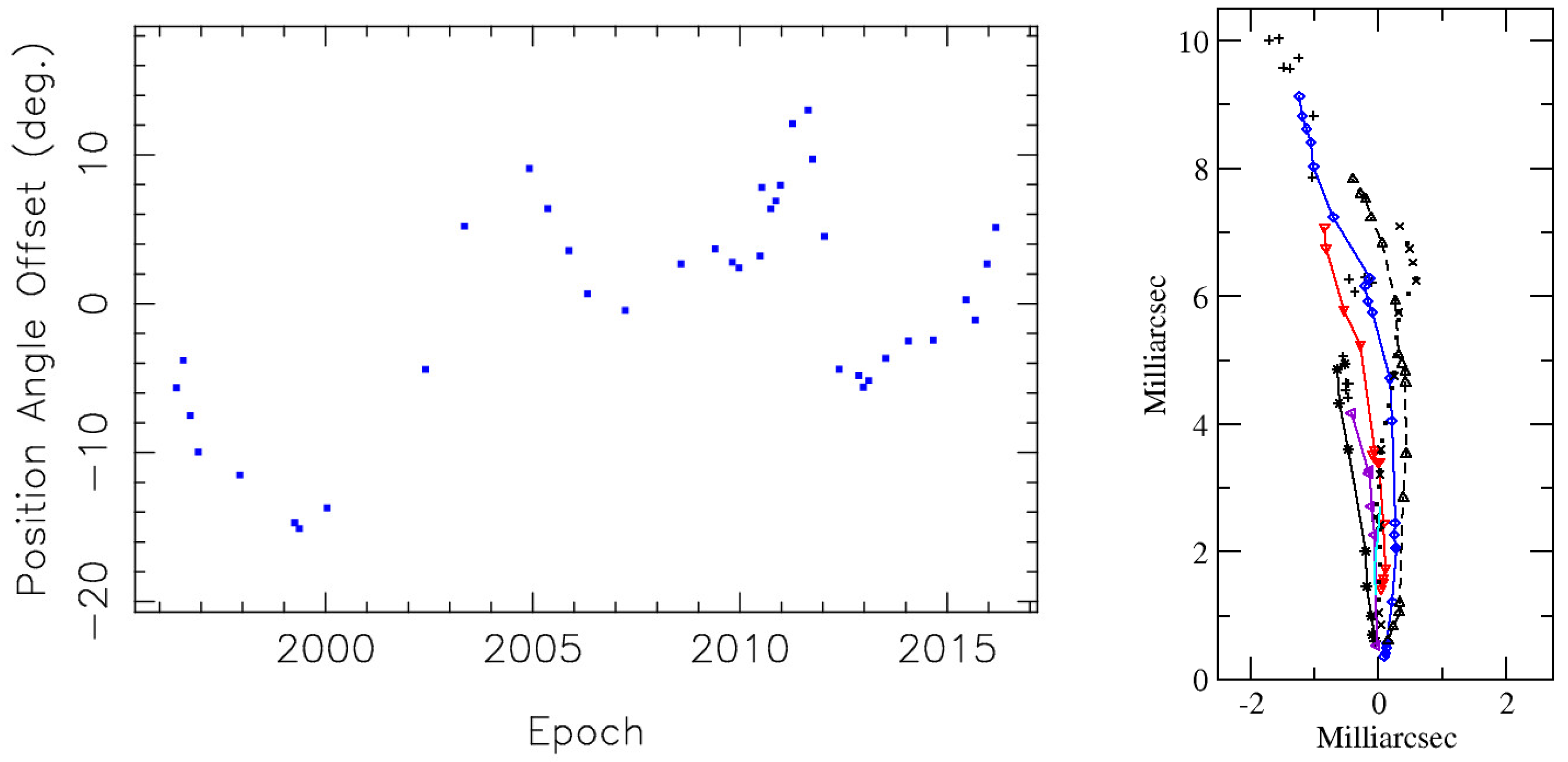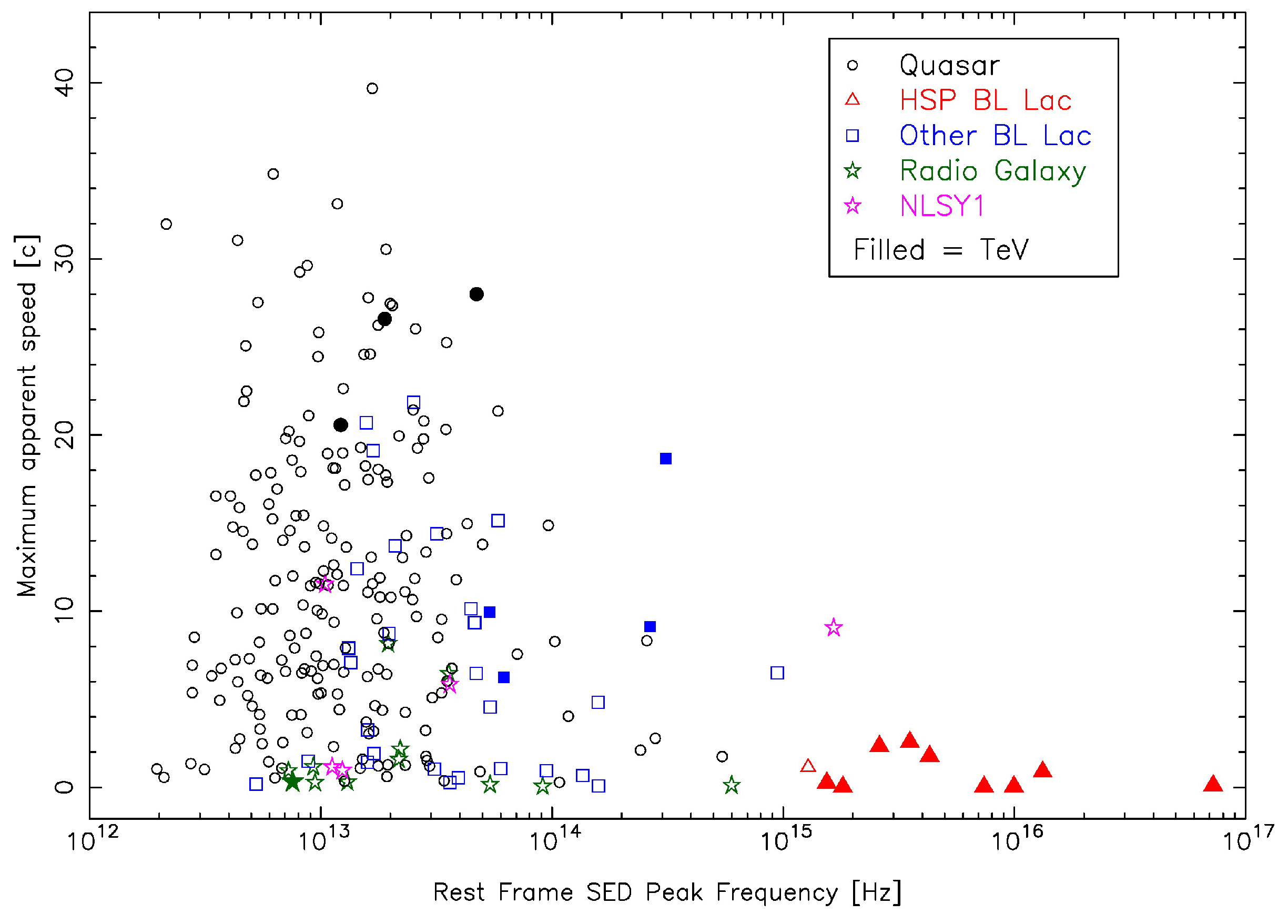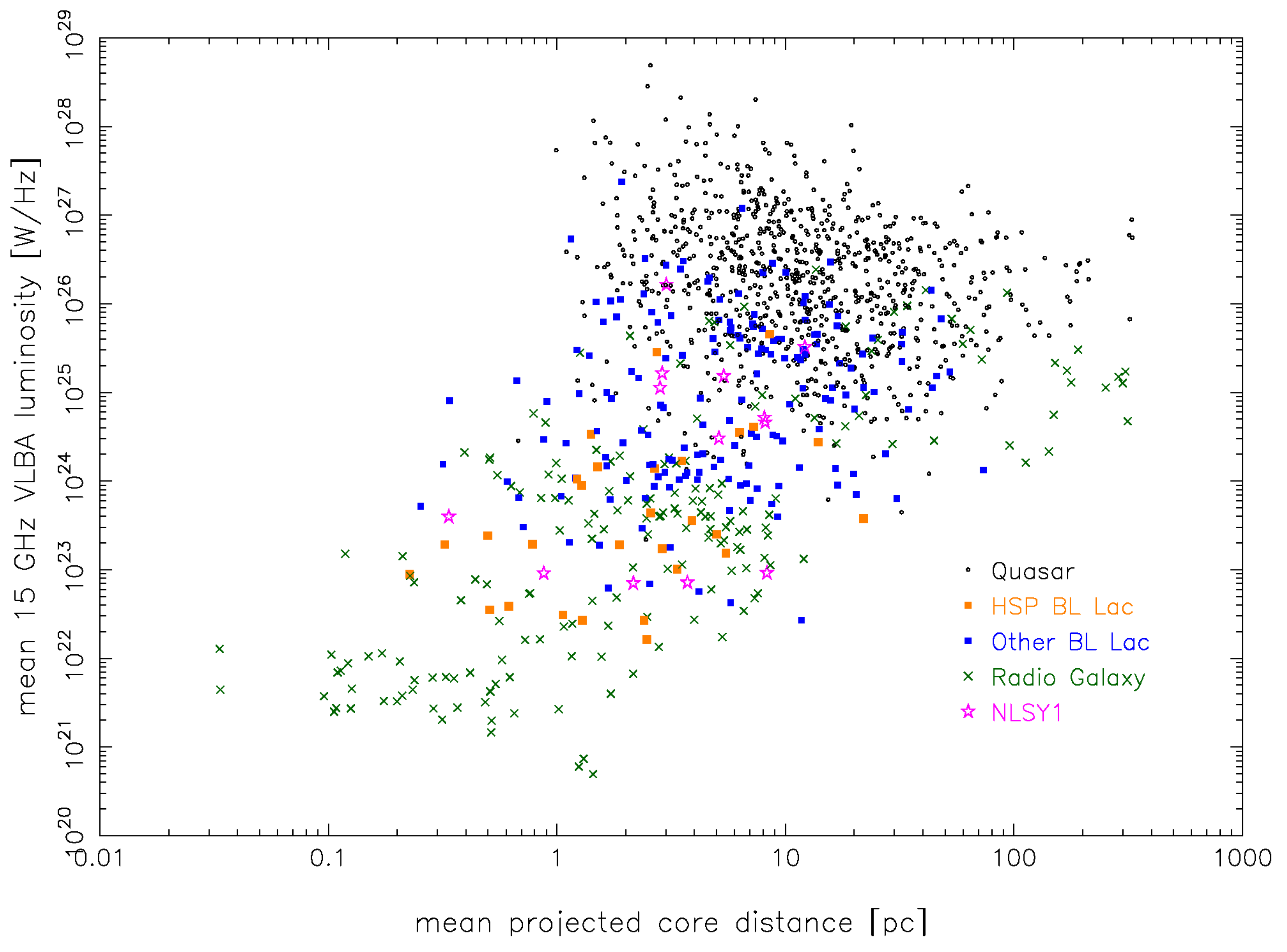AGN Jet Kinematics on Parsec-Scales: The MOJAVE Program
Abstract
:1. Introduction
2. Program Description
3. Research Highlights
3.1. Jet Kinematics
3.2. Swinging Jets
3.3. Trends with Synchrotron Peak Location
3.4. Narrow-Line Seyfert I Jets
4. Summary
Acknowledgments
Conflicts of Interest
References
- Kellermann, K.I.; Vermeulen, R.C.; Zensus, J.A.; Cohen, M.H. Sub-Milliarcsecond Imaging of Quasars and Active Galactic Nuclei. Astron. J. 1998, 115, 1295–1318. [Google Scholar] [CrossRef]
- Lister, M.L.; Aller, H.D.; Aller, M.F.; Cohen, M.H.; Homan, D.C.; Kadler, M.; Kellermann, K.I.; Kovalev, Y.Y.; Ros, E.; Savolainen, T.; et al. MOJAVE: Monitoring of Jets in Active Galactic Nuclei with VLBA Experiments. V. Multi-Epoch VLBA Images. Astron. J. 2009, 137, 3718–3729. [Google Scholar] [CrossRef]
- Ojha, R.; Kadler, M.; Böck, M.; Booth, R.; Dutka, M.S.; Edwards, P.G.; Fey, A.L.; Fuhrmann, L.; Gaume, R.A.; Hase, H.; et al. TANAMI: Tacking active galactic nuclei with austral milliarcsecond interferometry. I. First-epoch 8.4 GHz images. Astron. Astrophys. 2010, 519, A45. [Google Scholar] [CrossRef]
- Jorstad, S.G.; Marscher, A.P.; Agudo, I.; Smith, P.S.; Larionov, V.M.; Lähteenmäki, A. Multi-Frequency Observations of Gamma-Ray Blazar 1633+382. J. Astrophys. Astron. 2011, 32, 239–242. [Google Scholar] [CrossRef]
- Piner, B.G.; Pushkarev, A.B.; Kovalev, Y.Y.; Marvin, C.J.; Arenson, J.G.; Charlot, P.; Fey, A.L.; Collioud, A.; Voitsik, P.A. Relativistic Jets in the Radio Reference Frame Image Database. II. Blazar Jet Accelerations from the First 10 Years of Data (1994–2003). Astrophys. J. 2012, 758, 84. [Google Scholar] [CrossRef]
- Britzen, S.; Vermeulen, R.C.; Taylor, G.B.; Campbell, R.M.; Pearson, T.J.; Readhead, A.C.S.; Xu, W.; Browne, I.W.A.; Henstock, D.R.; Wilkinson, P. A multi-epoch VLBI survey of the kinematics of CJF sources. I. Model-fit parameters and maps. Astron. Astrophys. 2007, 472, 763–771. [Google Scholar] [CrossRef] [Green Version]
- Piner, B.G.; Edwards, P.G. First-epoch VLBA Imaging of 20 New TeV Blazars. Astrophys. J. 2014, 797, 25. [Google Scholar] [CrossRef]
- Kellermann, K.I.; Lister, M.L.; Homan, D.C.; Vermeulen, R.C.; Cohen, M.H.; Ros, E.; Kadler, M.; Zensus, J.A.; Kovalev, Y.Y. Sub-Milliarcsecond Imaging of Quasars and Active Galactic Nuclei. III. Kinematics of Parsec-scale Radio Jets. Astrophys. J. 2004, 609, 539–563. [Google Scholar] [CrossRef]
- Lister, M.L.; Homan, D.C. MOJAVE: Monitoring of Jets in Active Galactic Nuclei with VLBA Experiments. I. First-Epoch 15 GHz Linear Polarization Images. Astron. J. 2005, 130, 1389–1417. [Google Scholar] [CrossRef]
- Lister, M.L.; Aller, M.F.; Aller, H.D.; Hovatta, T.; Max-Moerbeck, W.; Readhead, A.C.S.; Richards, J.L.; Ros, E. Why Have Many of the Brightest Radio-loud Blazars Not Been Detected in Gamma-Rays by Fermi? Astrophys. J. Lett. 2015, 810, L9. [Google Scholar] [CrossRef]
- Atwood, W.B.; Abdo, A.A.; Ackermann, M.; Althouse, W.; Anderson, B.; Axelsson, M.; Baldini, L.; Ballet, J.; Band, D.L.; Barbiellini, G.; et al. The Large Area Telescope on the Fermi Gamma-Ray Space Telescope Mission. Astrophys. J. 2009, 697, 1071–1102. [Google Scholar] [CrossRef]
- Lister, M.L.; Aller, M.; Aller, H.; Hovatta, T.; Kellermann, K.I.; Kovalev, Y.Y.; Meyer, E.T.; Pushkarev, A.B.; Ros, E.; MOJAVE Collaboration; et al. γ-Ray and Parsec-scale Jet Properties of a Complete Sample of Blazars From the MOJAVE Program. Astrophys. J. 2011, 742, 27. [Google Scholar] [CrossRef]
- Lister, M.L.; Aller, M.F.; Aller, H.D.; Homan, D.C.; Kellermann, K.I.; Kovalev, Y.Y.; Pushkarev, A.B.; Richards, J.L.; Ros, E.; Savolainen, T. MOJAVE. X. Parsec-scale Jet Orientation Variations and Superluminal Motion in Active Galactic Nuclei. Astron. J. 2013, 146, 120. [Google Scholar] [CrossRef]
- Nolan, P.L.; Abdo, A.A.; Ackermann, M.; Ajello, M.; Allafort, A.; Antolini, E.; Atwood, W.B.; Axelsson, M.; Baldini, L.; Ballet, J.; et al. Fermi Large Area Telescope Second Source Catalog. Astrophys. J. Suppl. 2012. [Google Scholar] [CrossRef]
- Acero, F.; Ackermann, M.; Ajello, M.; Albert, A.; Atwood, W.B.; Axelsson, M.; Baldini, L.; Ballet, J.; Barbiellini, G.; Bastieri, D.; et al. Fermi Large Area Telescope Third Source Catalog. Astrophys. J. Suppl. 2015, 218, 23. [Google Scholar] [CrossRef]
- Pavlidou, V.; Angelakis, E.; Myserlis, I.; Blinov, D.; King, O.G.; Papadakis, I.; Tassis, K.; Hovatta, T.; Pazderska, B.; Paleologou, E.; et al. The RoboPol optical polarization survey of gamma-ray-loud blazars. Mon. Not. R. Astron. Soc. 2014, 442, 1693–1705. [Google Scholar] [CrossRef]
- Kharb, P.; Lister, M.L.; Cooper, N.J. Extended Radio Emission in MOJAVE Blazars: Challenges to Unification. Astrophys. J. 2010, 710, 764–782. [Google Scholar] [CrossRef]
- Homan, D.C.; Lister, M.L.; Kovalev, Y.Y.; Pushkarev, A.B.; Savolainen, T.; Kellermann, K.I.; Richards, J.L.; Ros, E. MOJAVE. XII. Acceleration and Collimation of Blazar Jets on Parsec Scales. Astrophys. J. 2015, 798, 134. [Google Scholar] [CrossRef]
- Lister, M.L.; Aller, M.F.; Aller, H.D.; Homan, D.C.; Kellermann, K.I.; Kovalev, Y.Y.; Pushkarev, A.B.; Richards, J.L.; Ros, E.; Savolainen, T. MOJAVE: XIII. Parsec-scale AGN Jet Kinematics Analysis Based on 19 years of VLBA Observations at 15 GHz. Astron. J. 2016, 152, 12. [Google Scholar] [CrossRef]
- Lister, M.L.; Marscher, A.P. Statistical Effects of Doppler Beaming and Malmquist Bias on Flux-limited Samples of Compact Radio Sources. Astrophys. J. 1997, 476, 572–588. [Google Scholar] [CrossRef]
- Miller-Jones, J.C.A. High-resolution radio observations of X-ray binaries. J. Phys. Conf. Ser. 2008, 131, 012057. [Google Scholar] [CrossRef]
- Cohen, M.H.; Meier, D.L.; Arshakian, T.G.; Clausen-Brown, E.; Homan, D.C.; Hovatta, T.; Kovalev, Y.Y.; Lister, M.L.; Pushkarev, A.B.; Richards, J.L.; et al. Studies of the Jet in BL Lacertae. II. Superluminal Alfvén Waves. Astrophys. J. 2015, 803, 3. [Google Scholar] [CrossRef]
- Homan, D.C.; Lister, M.L.; Kellermann, K.I.; Cohen, M.H.; Ros, E.; Zensus, J.A.; Kadler, M.; Vermeulen, R.C. Jet Collimation in Action: Realignment on Kiloparsec Scales in 3C 279. Astrophys. J. Lett. 2003, 589, L9–L12. [Google Scholar] [CrossRef]
- Caproni, A.; Abraham, Z.; Monteiro, H. Parsec-scale jet precession in BL Lacertae (2200+420). Mon. Not. R. Astron. Soc. 2013, 428, 280–290. [Google Scholar] [CrossRef]
- Alexander, P. A radio study of 3C 390.3—A precessing jet? Mon. Not. R. Astron. Soc. 1985, 213, 743–752. [Google Scholar] [CrossRef] [Green Version]
- Steenbrugge, K.C.; Blundell, K.M. Multiwavelength study of CygnusA—I. Precession and slow jet speeds from radio observations. Mon. Not. R. Astron. Soc. 2008, 388, 1457–1464. [Google Scholar] [CrossRef]
- Homan, D.C. Physical Properties of Jets in AGN. Int. J. Mod. Phys. Conf. Ser. 2012, 8, 163–171. [Google Scholar] [CrossRef]
- Aharonian, F.; Akhperjanian, A.G.; Bazer-Bachi, A.R.; Behera, B.; Beilicke, M.; Benbow, W.; Berge, D.; Bernlöhr, K.; Boisson, C.; Bolz, O.; et al. An Exceptional Very High Energy Gamma-Ray Flare of PKS 2155-304. Astrophys. J. Lett. 2007, 664, L71–L74. [Google Scholar] [CrossRef]
- Piner, B.G.; Pant, N.; Edwards, P.G. The Jets of TeV Blazars at Higher Resolution: 43 GHz and Polarimetric VLBA Observations from 2005 to 2009. Astrophys. J. 2010, 723, 1150–1167. [Google Scholar] [CrossRef]
- Ghisellini, G.; Tavecchio, F.; Chiaberge, M. Structured jets in TeV BL Lac objects and radiogalaxies. Implications for the observed properties. Astron. Astrophys. 2005, 432, 401–410. [Google Scholar] [CrossRef]
- Lister, M.L.; Cohen, M.H.; Homan, D.C.; Kadler, M.; Kellermann, K.I.; Kovalev, Y.Y.; Ros, E.; Savolainen, T.; Zensus, J.A. MOJAVE: Monitoring of Jets in Active Galactic Nuclei with VLBA Experiments. VI. Kinematics Analysis of a Complete Sample of Blazar Jets. Astron. J. 2009, 138, 1874–1892. [Google Scholar] [CrossRef]
- Arlen, T.; Aune, T.; Beilicke, M.; Benbow, W.; Bouvier, A.; Buckley, J.H.; Bugaev, V.; Cesarini, A.; Ciupik, L.; Connolly, M.P.; et al. Rapid TeV Gamma-Ray Flaring of BL Lacertae. Astrophys. J. 2013, 762, 92–105. [Google Scholar] [CrossRef]
- Giannios, D.; Uzdensky, D.A.; Begelman, M.C. Fast TeV variability from misaligned minijets in the jet of M87. Mon. Not. R. Astron. Soc. 2010, 402, 1649–1656. [Google Scholar] [CrossRef]
- Georganopoulos, M.; Kazanas, D. Decelerating Flows in TeV Blazars: A Resolution to the BL Lacertae-FR I Unification Problem. Astrophys. J. Lett. 2003, 594, L27–L30. [Google Scholar] [CrossRef]
- Lyutikov, M.; Lister, M. Resolving Doppler-factor Crisis in Active Galactic Nuclei: Non-steady Magnetized Outflows. Astrophys. J. 2010, 722, 197–203. [Google Scholar] [CrossRef]
- Savolainen, T.; Homan, D.C.; Hovatta, T.; Kadler, M.; Kovalev, Y.Y.; Lister, M.L.; Ros, E.; Zensus, J.A. Relativistic beaming and gamma-ray brightness of blazars. Astron. Astrophys. 2010, 512, A24. [Google Scholar] [CrossRef]
- Ackermann, M.; Ajello, M.; Atwood, W.B.; Baldini, L.; Ballet, J.; Barbiellini, G.; Bastieri, D.; Becerra Gonzalez, J.; Bellazzini, R.; Bissaldi, E.; et al. The Third Catalog of Active Galactic Nuclei Detected by the Fermi Large Area Telescope. Astrophys. J. 2015, 810, 14. [Google Scholar] [CrossRef]
- Deller, A.T.; Brisken, W.F.; Phillips, C.J.; Morgan, J.; Alef, W.; Cappallo, R.; Middelberg, E.; Romney, J.; Rottmann, H.; Tingay, S.J.; et al. DiFX-2: A More Flexible, Efficient, Robust, and Powerful Software Correlator. Publ. Astron. Soc. Pac. 2011, 123, 275–287. [Google Scholar] [CrossRef]





© 2016 by the authors; licensee MDPI, Basel, Switzerland. This article is an open access article distributed under the terms and conditions of the Creative Commons Attribution (CC-BY) license (http://creativecommons.org/licenses/by/4.0/).
Share and Cite
Lister, M.; The MOJAVE Collaboration. AGN Jet Kinematics on Parsec-Scales: The MOJAVE Program. Galaxies 2016, 4, 29. https://doi.org/10.3390/galaxies4030029
Lister M, The MOJAVE Collaboration. AGN Jet Kinematics on Parsec-Scales: The MOJAVE Program. Galaxies. 2016; 4(3):29. https://doi.org/10.3390/galaxies4030029
Chicago/Turabian StyleLister, Matthew, and The MOJAVE Collaboration. 2016. "AGN Jet Kinematics on Parsec-Scales: The MOJAVE Program" Galaxies 4, no. 3: 29. https://doi.org/10.3390/galaxies4030029
APA StyleLister, M., & The MOJAVE Collaboration. (2016). AGN Jet Kinematics on Parsec-Scales: The MOJAVE Program. Galaxies, 4(3), 29. https://doi.org/10.3390/galaxies4030029




